Showing Spotlights 33 - 40 of 77 in category All (newest first):
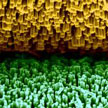 There is an almost infinite number of mechanical energy sources all around us - basically, anything that moves can be harvested for energy. These environmental energy sources can the very large, like wave power in the oceans, or very small, like rain drops or biomechanical energy from heart beat, breathing, and blood flow. With the increasing use of nanotechnology materials and applications in energy research, scientists are finding more and more ways to tap into these pretty much limitless sources of energy. Self-powered nanotechnology based on piezoelectric nanogenerators aims at powering nanodevices and nanosystems using the energy harvested from the environment in which these systems are suppose to operate.
There is an almost infinite number of mechanical energy sources all around us - basically, anything that moves can be harvested for energy. These environmental energy sources can the very large, like wave power in the oceans, or very small, like rain drops or biomechanical energy from heart beat, breathing, and blood flow. With the increasing use of nanotechnology materials and applications in energy research, scientists are finding more and more ways to tap into these pretty much limitless sources of energy. Self-powered nanotechnology based on piezoelectric nanogenerators aims at powering nanodevices and nanosystems using the energy harvested from the environment in which these systems are suppose to operate.
Nov 19th, 2013
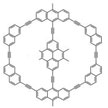 Most molecular machines operate by using chemical reactions, which lead to irreversible damage to the machine molecules themselves over time. Moreover, in most scenarios, the measurement and control of the molecular machine status are separated into distinct steps, e.g., the molecular motion is controlled by a chemical reaction, but is then detected by spectroscopy or electrochemistry. Researchers have now proposed a new type of molecular machine without chemical reactions and where the measurement/control mechanisms are combined into one.
Most molecular machines operate by using chemical reactions, which lead to irreversible damage to the machine molecules themselves over time. Moreover, in most scenarios, the measurement and control of the molecular machine status are separated into distinct steps, e.g., the molecular motion is controlled by a chemical reaction, but is then detected by spectroscopy or electrochemistry. Researchers have now proposed a new type of molecular machine without chemical reactions and where the measurement/control mechanisms are combined into one.
Nov 6th, 2013
 Steerable nanodevices are envisioned for a multitude of applications. For example, magnetic nanodevices can be controlled via external magnetic fields. So far, scientist mainly have used costly synthetic routes to design and synthesize such devices. Now, though, a team of scientists has shown that a very simple route based on solution chemistry can also lead to such steerable machines. So far, most nano-and microscale propeller designs have been based on a biomimetic approach. The new approach is based on random aggregates.
Steerable nanodevices are envisioned for a multitude of applications. For example, magnetic nanodevices can be controlled via external magnetic fields. So far, scientist mainly have used costly synthetic routes to design and synthesize such devices. Now, though, a team of scientists has shown that a very simple route based on solution chemistry can also lead to such steerable machines. So far, most nano-and microscale propeller designs have been based on a biomimetic approach. The new approach is based on random aggregates.
Nov 4th, 2013
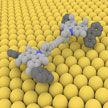 Designing, building, and running molecule-sized nanocars has become an active field of research among nanotechnology scientists. Based on research to reinvent the wheel for nanotechnology, efforts range from the original nano car developed by James Tour at Rice University in 2005 - which had buckyball wheels and flexible axles, and served as a proof-of-concept for the manufacture of machines at the nanoscale - to 'nanodragsters', and a nano car with molecular 4-wheel drive. A new Perspective article in ACS Nano describes how this field began, its growth, and list problems to be solved.
Designing, building, and running molecule-sized nanocars has become an active field of research among nanotechnology scientists. Based on research to reinvent the wheel for nanotechnology, efforts range from the original nano car developed by James Tour at Rice University in 2005 - which had buckyball wheels and flexible axles, and served as a proof-of-concept for the manufacture of machines at the nanoscale - to 'nanodragsters', and a nano car with molecular 4-wheel drive. A new Perspective article in ACS Nano describes how this field began, its growth, and list problems to be solved.
Jan 15th, 2013
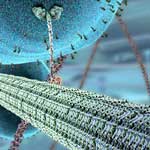 A look at what is happening in the field of artificial nanoscale motors and molecular machinery. These nanomachines could one day perform functions similar to the biological molecular motors found in living cells, things like transporting and assembling molecules, or facilitating chemical reactions by pumping protons through membranes. Researchers have reported a light-powered DNA locomotion device that is capable of autonomous and reversible motion along an oligonucleotide track. The direction of motion can be switched using different wavelengths of light. Compared with other reported DNA walkers, this new strategy not only preserves the autonomous and controllable movement but also provides a reusable track, making it feasible to reset the device after the complete trip, as observed in nature for kinesin and myosin.
A look at what is happening in the field of artificial nanoscale motors and molecular machinery. These nanomachines could one day perform functions similar to the biological molecular motors found in living cells, things like transporting and assembling molecules, or facilitating chemical reactions by pumping protons through membranes. Researchers have reported a light-powered DNA locomotion device that is capable of autonomous and reversible motion along an oligonucleotide track. The direction of motion can be switched using different wavelengths of light. Compared with other reported DNA walkers, this new strategy not only preserves the autonomous and controllable movement but also provides a reusable track, making it feasible to reset the device after the complete trip, as observed in nature for kinesin and myosin.
Sep 19th, 2012
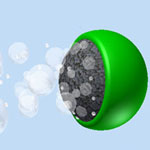 Man-made micro- and nanoscale motors have received a tremendous recent interest owing to their great potential for diverse potential applications, ranging from targeted drug delivery, microchip diagnostics or environmental remediation. Particular attention has been given to self-propelled chemically-powered micro/nanoscale motors, such as catalytic nanowires, microtube engines, or spherical Janus microparticles. Although significant progress over the past 10 years has greatly advanced the capabilities of these tiny man-made machines, such catalytic motors have predominantly relied on an external hydrogen peroxide fuel that impedes many practical applications. Researchers have now demonstrated the first example of a water-driven bubble-propelled micromotor that eliminates the requirement for the common hydrogen peroxide fuel.
Man-made micro- and nanoscale motors have received a tremendous recent interest owing to their great potential for diverse potential applications, ranging from targeted drug delivery, microchip diagnostics or environmental remediation. Particular attention has been given to self-propelled chemically-powered micro/nanoscale motors, such as catalytic nanowires, microtube engines, or spherical Janus microparticles. Although significant progress over the past 10 years has greatly advanced the capabilities of these tiny man-made machines, such catalytic motors have predominantly relied on an external hydrogen peroxide fuel that impedes many practical applications. Researchers have now demonstrated the first example of a water-driven bubble-propelled micromotor that eliminates the requirement for the common hydrogen peroxide fuel.
Aug 23rd, 2012
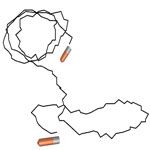 The catalytic conversion of chemical to mechanical energy, which is ubiquitous in biological systems, also is the basis for many of the engine systems that nanotechnology researchers are developing. Catalytic 'engines' will be key components of active micron- and sub-micron scale systems for controlled movement, particle assembly, and separations. So far, most of these catalytic micro- and nanomotors use hydrogen peroxide as the fuel. The major problem associated with this is that the produced oxygen bubbles make the observation and detailed study of these motors difficult. Researchers at the Pennsylvania State University have now introduced a new bubble-free, high efficient nanomotor system that involves the operation of a miniaturized copper-platinum nanobattery.
The catalytic conversion of chemical to mechanical energy, which is ubiquitous in biological systems, also is the basis for many of the engine systems that nanotechnology researchers are developing. Catalytic 'engines' will be key components of active micron- and sub-micron scale systems for controlled movement, particle assembly, and separations. So far, most of these catalytic micro- and nanomotors use hydrogen peroxide as the fuel. The major problem associated with this is that the produced oxygen bubbles make the observation and detailed study of these motors difficult. Researchers at the Pennsylvania State University have now introduced a new bubble-free, high efficient nanomotor system that involves the operation of a miniaturized copper-platinum nanobattery.
Oct 17th, 2011
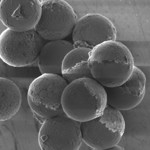 Self-propelled motion of engineered nanomaterials can be useful in applications such as bottom-up assembly of structures, pattern formation, microfluidic diagnostic systems, or drug delivery at specific locations. While nature has perfected nano- and microscale motor systems, movement at the nanoscale is still a massively challenging problem for nanotechnology researchers. There are various approaches to creating self-powered micro- and nanosized motors and many researchers have focused on catalytic conversion of chemical to mechanical energy. Whereas the catalytic reactions of small molecules have been the focus of recent nanomotor research efforts, polymerization has not attracted any interest; until now. Researchers describe a new type of micromotor that is powered by a polymerization reaction and deposits tiny threads along its trail like a microspider.
Self-propelled motion of engineered nanomaterials can be useful in applications such as bottom-up assembly of structures, pattern formation, microfluidic diagnostic systems, or drug delivery at specific locations. While nature has perfected nano- and microscale motor systems, movement at the nanoscale is still a massively challenging problem for nanotechnology researchers. There are various approaches to creating self-powered micro- and nanosized motors and many researchers have focused on catalytic conversion of chemical to mechanical energy. Whereas the catalytic reactions of small molecules have been the focus of recent nanomotor research efforts, polymerization has not attracted any interest; until now. Researchers describe a new type of micromotor that is powered by a polymerization reaction and deposits tiny threads along its trail like a microspider.
Sep 12th, 2011
 There is an almost infinite number of mechanical energy sources all around us - basically, anything that moves can be harvested for energy. These environmental energy sources can the very large, like wave power in the oceans, or very small, like rain drops or biomechanical energy from heart beat, breathing, and blood flow. With the increasing use of nanotechnology materials and applications in energy research, scientists are finding more and more ways to tap into these pretty much limitless sources of energy. Self-powered nanotechnology based on piezoelectric nanogenerators aims at powering nanodevices and nanosystems using the energy harvested from the environment in which these systems are suppose to operate.
There is an almost infinite number of mechanical energy sources all around us - basically, anything that moves can be harvested for energy. These environmental energy sources can the very large, like wave power in the oceans, or very small, like rain drops or biomechanical energy from heart beat, breathing, and blood flow. With the increasing use of nanotechnology materials and applications in energy research, scientists are finding more and more ways to tap into these pretty much limitless sources of energy. Self-powered nanotechnology based on piezoelectric nanogenerators aims at powering nanodevices and nanosystems using the energy harvested from the environment in which these systems are suppose to operate.
 Subscribe to our Nanotechnology Spotlight feed
Subscribe to our Nanotechnology Spotlight feed





